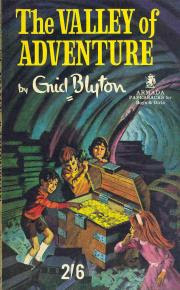The Valley of Adventure is the third book in the series. This starts differently from the other two books. There is no relaxed fun and slow build up. It has a rapid start with Jack, Phillip, Lucy Ann and Dinah finding themselves marooned in a strange valley in the middle of nowhere with criminal elements for company. They have to figure out a way either to get out of the place or survive there while remaining out of sight of the criminals. This story kind of reminded me of Robinson Crusoe, one of the favorite reads of my childhood. Of course, the children find easier solutions for their food and clothing needs. But the idea of being in the lap of nature separated from rest of humanity is similar. The settings are much more exotic than the other books. They were quite close to their home in the first two books. In this book, they are not even in their own country – they are somewhere in the middle of Europe. That way the exoticism index is taken a few notches up.
Like in the other books, here also we have secret caves and passages. We also have a treasure hunt and we are introduced to a magical place like the caves of Aladdin and Ali Baba. This is one of the specialties of this one. This book however does not have any birds for Jack nor any interesting animals for Phillip. All he finds is a lizard that doesn’t do much except serving to irritate Dinah. Of course, Jack also finds a hen towards the end of the story. But a hen is not exactly and ornithologist’s delight. Talking of the hen, I found all the fuss the children made about the hen kind of strange and inconsistent. The children love the hen so much and fear the criminals don’t kill and eat it. But the children themselves are meat eaters and definitely eat chicken. This is one dichotomy I find in all Enid Blyton books. The characters seem to love animals so much and still eat the very same animals. And she does not even try to explain it in a philosophical way like in certain Native Indian lore.
Unlike the earlier two books, here the children manage to take on the villains on their own might without depending on their detective friend. However, they are aided by luck. While the children do attempt dangerous feats, the danger levels don’t peak suddenly like in the other books. This one maintains a steady pace through and through.
There is of course the usual fun around Kiki the parrot’s mix up of words and phrases. And food and eating as always occupies a place of importance, more so since lack of food happened to be one of the major initial concerns. I think Enid Blyton does a fabulous joy of bringing in food as a relief in the middle of intense scenes. In the real life also, there is a tendency to eat tasty food as a stress reliever. So this works really well.
I have seen it mentioned somewhere that Enid Blyton usually does not mention the war much in her books and also usually does not clearly specify the time the stories are set in. In this one however she mentions the war and that second world war is long over when this story is taking place.
Overall, I think this a more of a pure play adventure story than the earlier books and does not have much of the warmer fuzzier elements. Also, since there aren’t too many people here, we don’t see too much of the children’s character coming out in this one. It is mostly just action. That way it scores on setting and pace but loses out on some of the other aspects. So I would not have this story in running for the best book of this series.

No comments:
Post a Comment
Kind words of appreciation/feedback